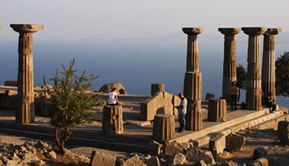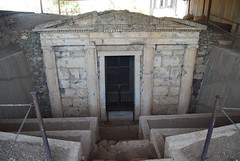Cimon: The Man History Forgot
He championed Athens against the Persians, commissioned inspiring works – even laid the foundations of the Academy. So why, asks David Stuttard, is Cimon not better known today?

The Battle of Salamis, in which Cimon fought, oil on canvas by Wilhelm von Kaulbach, 1868 (Maximilianeum, Munich/Wikimedia Commons)
He is perhaps the most important Greek to have slipped from public consciousness outside the groves of Academe. Which is ironic, given that he was responsible for planting those groves in the first place. He is Cimon, son of Miltiades. In the years when the Athenian Acropolis stood ruined (between Xerxes’ burning of its temples and Pericles’ building of the Parthenon), it was Cimon, more than any other, who championed Athens’s interests, tightening control of her emerging empire, opening up sea lanes, driving out the Persians from occupied Greek city-states, launching raids on enemy forces mustering in Asia Minor, and commissioning civic construction projects and artworks that would enhance the daily life of fellow citizens. All the while he projected to the panhellenic world the message that, though sacked and ruined in the Persian Wars, Athens had arisen like a phoenix from the flames, stronger – and more powerful – than before.
Despite his towering achievements, Cimon is largely absent from the history books, including the ancient ones. Even his great-nephew, Thucydides, mentions him just five times by name in his History of the Peloponnesian War. The historian indeed devotes no more than a sentence to his victory at the Battle of Eurymedon, arguably Athens’s most important victory since Marathon. When Cimon is allowed to step onto the stage, there is still a tendency to view him as an out-of-date reactionary, an anachronistic stop-gap, a conservative at odds with the ambitions of democracy. So, if he really was so pivotal a figure, if he really did achieve such triumphs, why is his memory so neglected? Why has history forgotten Cimon?
From the start, Cimon was an anomaly. A member of the aristocratic Philaid family, he was born in 510 bc, two years before the dawn of Athenian democracy, but not in Athens. Rather, his origins lie in Athenian-held territories in the Thracian Chersonese on the northern shores of the Hellespont, where his father Miltiades had been appointed ruler by Athens’s last tyrant, Hippias. By now, the area had been subsumed against its will within the Persian Empire, and Miltiades had even had to join the Persian Great King, Darius, on a campaign to Scythia. By the time Cimon turned 11, however, the occupied Ionian Greek city-states rebelled against their masters. The revolt was ultimately unsuccessful, and, fearing reprisals, Miltiades and his family were forced to flee. Not all of them made it to Athens. One of their triremes was captured by its Persian pursuers, and its captain, Cimon’s elder brother, bundled off to Asia Minor where he lived out the rest of his life.
In Athens the family met a mixed reception. Miltiades’ enemies arraigned him for ruling as a tyrant, but, acquitted, he was soon so well established that his tribe elected him their general. Meanwhile Cimon, now 17, found life in Athens taxing. His mother was a tattooed Thracian princess, and pure-born Athenians were taunting him for being uncouth, unread, uncivilized, charges that would pursue him all his life. When only three years later, in 490 bc, at Marathon, Miltiades led Athens’s hoplite army to unexpected victory over a Persian expedition force, whose mission was to add the city-state to its growing empire and reinstall the exiled Hippias as ruler, the family was the toast of Greece. But still Miltiades’ opponents looked for ways to do him down, and, when an attack he led on Paros failed, they pounced. Prosecuted by the merciless Xanthippus, head of the rival Alcmaeonid family, he was condemned to pay a hefty fine, but died in prison of his wounds before he could amass the money.
Suddenly, aged 21, Cimon found himself the head, the capo, of the Philaids, potentially crippled by his father’s fine. It is evidence of his brilliance and charisma that he not only did not go under, but emerged from those dark days at the centre of a powerful nexus of political allies, joined by both his marriage and his sister’s to Athens’s leading dynasties. Theirs was a vital alliance, for already the populist Themistocles was weaponizing ostracism, using the annual vote to target wealthy adversaries and remove them from the city for ten years. Yet despite the polar opposition between Cimon’s powerbase and Themistocles’, in the face of renewed Persian attack, the 30-year-old Cimon showed his statesmanship and rose above domestic politics.
With Athenians divided between old-school landowners, keen to stay and fight a hoplite-battle against Persia, and Themistocles’ supporters, ready to abandon Athens and take to the sea in their newly built fleet, Cimon swung opinion in his opponent’s favour. Leading a loyal band of followers up onto the Acropolis, he dedicated his horse’s bridle (symbol of his patrician status) to Athena before, hefting a shield, he marched down to the sea. It was a pivotal moment in Athens’s (and world) history. When in the Bay of Salamis Greek triremes smashed the Persian fleet, they owed their victory as much to Cimon’s unifying gesture as to Themistocles’ long-held military vision.
However, Greece itself was far from united. Many city-states had already either sided with the Persians or agreed to remain neutral. Even the Peloponnesians who fought at Salamis were refusing to venture north beyond the Isthmus of Corinth to join battle on land, and in the lull of winter it fell to Athens to persuade them to change their minds. Tellingly, Cimon was among the envoys that the principled Athenian commander, Aristides, sent to Sparta to negotiate. The mission was successful; Sparta and her Peloponnesian allies stood alongside Athens at the Battle of Plataea; the Persians were routed; and the rest is history.
And yet it is precisely this history – and Cimon’s part in it – that is so obscure. From Thucydides and later writers, we learn of Cimon and Aristides serving as generals in an allied Greek campaign designed to wrest control of crucial sea lanes – first the Hellespont and then the Bosporus – from Persia. We read how the commander-in-chief, the Spartan regent, Pausanias, behaved so abominably in Byzantium that the Ionian city-states complained, had him sent home, and announced that they would follow only Aristides and Cimon; how on Delos Aristides had them swear an oath of loyalty to Athens and drew up agreements about how much each member-state should contribute to their newly founded League; how Cimon spearheaded military operations, annihilating Persia’s garrison at Eion on the River Strymon (thereby gaining hold of vital goldmines), making the seas safe by ridding Scyros of pirates, and, amid fears that the Great King was amassing troops and ships for a renewed assault on Athens, leading his League troops to victory in two battles beside the River Eurymedon, one naval the other on land, on the same day.
But Cimon’s energies were not confined to fighting. In Athens he worked strenuously to improve the lives of fellow citizens, not only by removing fences from his orchards outside the city so that anyone might pick the fruit or by distributing cash and clothing to the needy, but by initiating public works: planting plane trees in the baking Agora, the city’s square, so that business might be conducted in the shade; laying out well-watered groves beside the shrine of Academus (the Academy, or ‘Academe’) and its nearby running tracks; enlarging and enhancing the sheer walls of the Acropolis; and draining swamps south to the sea to reclaim land on which Long Walls would soon be built to link Athens and Piraeus and so protect supply lines should the city be besieged.
In addition, he bolstered the Athenians’ sense of identity. On his campaign to Scyros he had discovered a gigantic skeleton, identified as that of Theseus, the legendary king who had united Attica under Athens’ rule and governed as ‘first citizen’, a proto-democrat in all but name. Amid great pomp Cimon brought the relics home and had a temple built to house them – the Theseion, sited not on the lofty Acropolis but in the residential city centre, adorned with paintings showing the hero fighting Amazons and Centaurs, or diving deep into the sea in a feat that would prove to the world (and to his enemy, the Cretan ‘Great King’ Minos) that he was the true son of the sea-god, Poseidon.
Such images of Athens triumphing over her barbaric enemies were blazoned, too, in a triptych in a new arcade, the Stoa Poikile (‘Painted Stoa’), bankrolled by Cimon’s brother-in-law, and abutting the north side of the Agora, where a painting of the Battle with the Amazons was hung beside one showing the Sack of Troy and another Athens’s victory at Marathon, with Cimon’s father Miltiades centre stage. It was not the only memorial to Marathon that Cimon caused to be commissioned. At Delphi the up-and-coming sculptor Pheidias executed a bronze sculptural group showing Athens’s legendary heroes standing proud beside Athena and Apollo and, alongside them, Miltiades. At this panhellenic sanctuary the message was clear: Greece owed the victory at Marathon not just to Athens and her gods, but to the father of her leading living general, Cimon.
Of course, for Cimon’s rivals, displays like this were anathema, and they looked for an opportunity to bring him down. They found it in 461 bc. Just three years earlier, Cimon had responded to Spartan pleas for help with military aid to quell a slave uprising following a devastating earthquake. His mission was a failure. Many in his army were staunch democrats, opposed to Sparta’s totalitarian regime. Fearing that, rather than alleviate the situation the Athenians would inflame it, the Spartans ungraciously sent them home. Cimon was not just humiliated. He was dangerously exposed.
Throughout his career he had advocated maintaining a close diplomatic relationship with Sparta. Athens and Sparta were, he insisted, like two perfectly matched horses yoked to the chariot of Greece. Each needed the other to achieve its ends. Others disagreed, not least the leading radical democrats, whose grip over Athenian politics was tightening. No sooner was Cimon home than Pericles (son of Miltiades’ bête noir, Xanthippus) tried to prosecute him. When the move failed, the radicals unleashed another weapon: ostracism. Such was the public animus they managed to whip up that Cimon, who had done so much for Athens, was exiled for ten years.
In his absence, relations with Sparta deteriorated further. Battles were fought and battle-lines redrawn, and by the time Cimon returned the political climate was very different. Determined to switch the focus of hostilities from mainland Greece to Persia, in 450 bc he led a taskforce to Cyprus to attack the Great King’s interests there, but during a siege an epidemic struck. Among the casualties was Cimon. His last command to his lieutenants was to conceal his death, so his men fought thinking that he was directing them. The damage they inflicted on the enemy fleet was such that Persia entered into negotiations and (perhaps) made peace. Bookended by Miltiades’ triumph at Marathon and Cimon’s posthumous victory in Cyprus, the Persian Wars were over.
Which brings us back to our initial question. If Cimon achieved so much, why has history forgotten him? One answer almost certainly is: Pericles. By the time of Cimon’s death, Pericles already dominated Athens. We have seen how he and his father, Xanthippus, launched lawsuits against Cimon and Miltiades, not just political rivals but (equally important in Athenian high society) the leaders of a rival family. Moreover, as an advocate of ‘putting Athens first’, Pericles was pathologically opposed to Cimon’s policy of concord with Sparta, something he regarded as appeasement if not downright treachery – and as an avid populist, he had no interest in preserving Cimon’s memory.
Not that he needed actively to erase it. In a society that built its history on fading memories and the occasional oral overview (most famously the annual speech in honour of the war dead), simply not mentioning Cimon meant that his star grew fainter. And there was so much to eclipse it, not least the monumental building programme that Pericles began just three years after Cimon’s death. While sculptures on the Parthenon use familiar motifs to extol Athens’s mythological defeat of the barbarian ‘Other’ familiar from the Theseion and Stoa Poikile (the Amazons, the Centaurs and the Trojans), viewers are left to draw their own comparisons with battles from the Persian Wars. No one who sees them thinks of Cimon.
Nor have the accidents of preservation helped. Visit modern Athens and it is the legacy of Pericles that dominates the skyline, the temples that he masterminded, buildings that, even ruined, Thucydides predicted, would suggest that ‘the city had been twice as powerful as it really is’. As for Cimon’s legacy, his plane trees no longer cast their shade across the Agora, cafés and streets bestride sad ruins of the Stoa Poikile, and even the site of the Theseion remains lost beneath the Plaka, while the once-beautiful Academy lies smothered in the city’s urban sprawl. All that is left of Cimon for most visitors to see is a handful of scratched ostraca that bear his name exhibited amid a plethora of others in museum cabinets.
But in the end the greatest culpability lies with history itself, or rather with historiography. We derive much of our historical knowledge of the fifth century bc from its first two great historians, Herodotus and Thucydides. But, writing about the Persian invasions of the Greek mainland, Herodotus was not interested in their aftermath. His narrative ends too late for Cimon to play any major role. As for Thucydides, his narrative begins too late, and while he sketches out the period of the Pentecontaetia (the roughly 50 years between the Persian and Peloponnesian Wars) he does so in just 28 short chapters – no room there to dwell on his great-uncle Cimon’s triumphs, let alone to reimagine any of his speeches in the way he reimagined some of Pericles’.
Already in the generations following his death, Cimon was largely forgotten. Ask most of Thucydides’ contemporaries what they knew of Cimon, and you would probably have heard only salacious gossip about the uncouth half-Thracian’s heavy drinking or his whoring or his scandalous, incestuous relationship with his clever, sultry sister, Elpinice – all so predictable, the product of political vitriol, and probably not a word of it true.
Yet without Cimon it could all have been so very different. Without his energy and his diplomacy, without his military skills, without his commissioning of artists, architects and sculptors to enhance and glorify his city, the foundations on which ‘Periclean Athens’ rose might never have been laid; conversely had his policy of not provoking Sparta been adhered to, the ruinous Peloponnesian War that saw Athens defeated and humiliated might well have been averted.
Nebulous he may be, but Cimon casts a long shadow, and if we are to understand a period of history when many of the values and ideas that still shape our lives were first propounded, it is time we turned the spotlight back towards him and recognize the central role he played in Athenian history.









